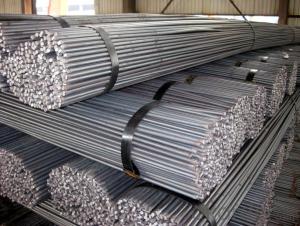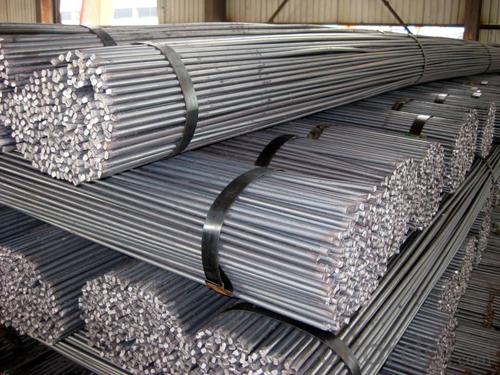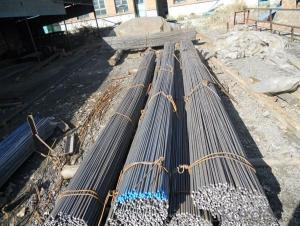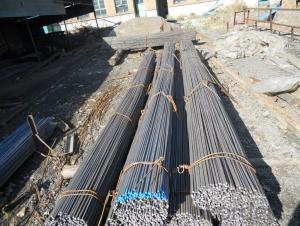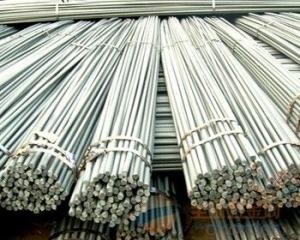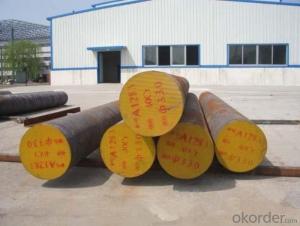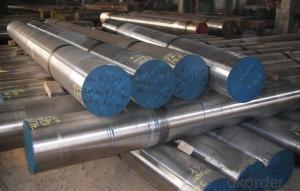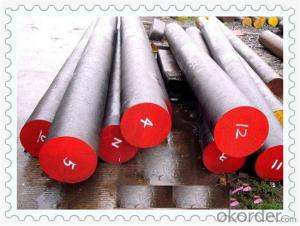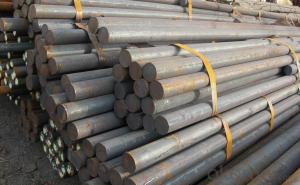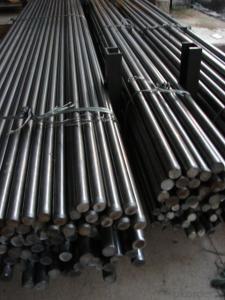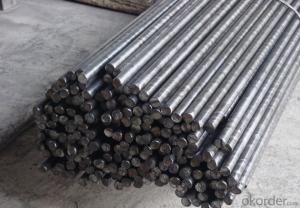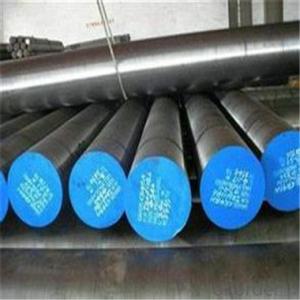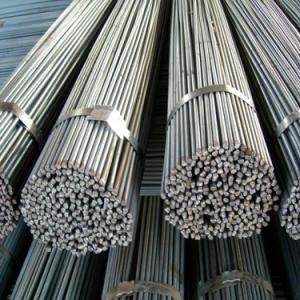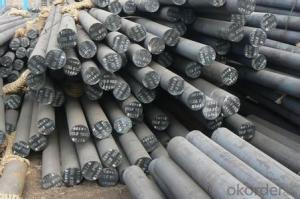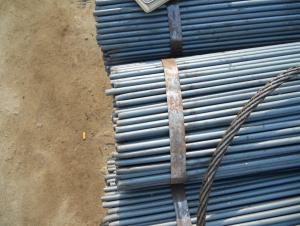GB 45#/SAE 1045 Steel Round Bar 20mm/25mm
- Loading Port:
- China main port
- Payment Terms:
- TT or LC
- Min Order Qty:
- 50 m.t
- Supply Capability:
- 10000 m.t/month
OKorder Service Pledge
OKorder Financial Service
You Might Also Like
GB 45#/SAE 1045 Steel Round Bar 20mm/25mm
Description:
-Specification: 20mm/25mm
-Length: 6m/12m
-Standard: GB/SAE/Japanese Standard
-Material: GB 45#/SAE1045/S45C
Chemical Composition of GB 45#/SAE 1045 Steel Round Bar 20mm/25mm:
| C | Si | Mn | P | S | Ni | Cr | Cu |
| 0.42-0.50 | 0.17-0.37 | 0.50-0.80 | ≤0.035 | ≤0.035 | ≤0.30 | ≤0.25 | ≤0.25 |
Packaging & Delivery of GB 45#/SAE 1045 Steel Round Bar 20mm/25mm:
Packaging Detail: All goods are packed in bundle with steel strips and shipped by break bulk vessel or container (depend on target market and different ports)
Delivery Detail: 45 days
MOQ: 50 tons per specification; we can negotiate the quantity if the specification is normal or we have stock of one specification.
Weight: The price invoicing on theoretical weight basis or actual weight basis depends on customer’s request.
Shipment: The shipment of bulk break or container is depends on customer’s request and the situation of the port of destination.
Documents given: Full set of original clean on board bill of lading; Original signed commercial invoice; Original packing list; Policy of insurance; Certificate of origin and what the target market needs.
Payment:
-Invoicing on theoretical weight or actual weight as customer's request.
-FOB, CFR or CIF.
-Regular terms of payment:
1, 30% payment in advance, the remaining balance (70% payment) against the copy of B/L.
2, 30% payment in advance, the remaining balance (70% L/C) against the copy of B/L.
3, Negotiable.
Images of GB 45#/SAE 1045 Steel Round Bar 20mm/25mm:
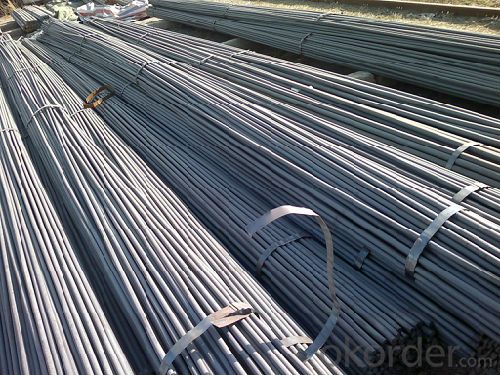
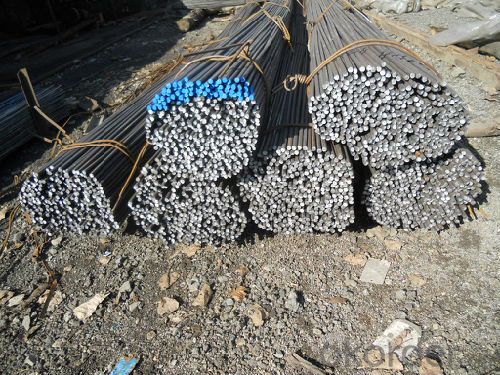
*If you would like to get our price, please inform us the size, standard/material and quantity. Thank you very much for your attention.
- Q: What are the advantages of using mild steel round bars?
- There are several advantages of using mild steel round bars in various applications. Firstly, mild steel round bars have excellent strength and durability. They are able to withstand high amounts of stress and pressure, making them suitable for use in construction, manufacturing, and engineering projects. The strength of mild steel round bars ensures that they do not easily deform or break under heavy loads, providing a reliable and long-lasting solution. Secondly, mild steel round bars have good weldability. They can be easily joined or attached to other materials through welding, making them versatile in different applications. This allows for easy customization and flexibility in design, as the bars can be shaped and connected to create complex structures or components. Additionally, mild steel round bars have a low carbon content, making them more cost-effective compared to other types of steel. They are readily available and affordable, making them a popular choice in various industries. Moreover, mild steel round bars have good machinability. They can be easily cut, drilled, and shaped using common machining techniques, allowing for easy fabrication and customization. This makes them suitable for a wide range of applications, from construction to automotive components. Lastly, mild steel round bars have good corrosion resistance. While they may not be as corrosion-resistant as stainless steel, they still offer adequate protection against rust and other forms of corrosion. This makes them suitable for outdoor applications or environments with high humidity or exposure to moisture. In summary, the advantages of using mild steel round bars include their excellent strength and durability, good weldability, cost-effectiveness, machinability, and corrosion resistance. These factors make them a reliable and versatile choice for various industrial and construction applications.
- Q: Are steel round bars available in different lengths?
- Indeed, there is a variety of lengths for steel round bars. These bars are designed in diverse lengths to cater to various needs and applications. The range of lengths may differ depending on the supplier or manufacturer. Typically, steel round bars are commonly available in lengths between 6 and 12 feet. However, it is also possible to acquire custom lengths through special requests. This wide range of options grants more flexibility in construction and fabrication projects, as it facilitates the ability to cut or modify the bars according to specific requirements.
- Q: What are the advantages of using precipitation-hardening steel round bars?
- There are several advantages of using precipitation-hardening steel round bars in various applications. Firstly, these bars offer exceptional strength and hardness, which makes them suitable for use in industries that require robust and durable materials. The precipitation-hardening process involves heat treatment, which increases the strength of the steel, making it highly resistant to wear, deformation, and fatigue. Secondly, precipitation-hardening steel round bars have excellent corrosion resistance properties. This makes them ideal for applications in marine environments or industries where exposure to harsh chemicals or corrosive substances is common. The steel's resistance to corrosion helps ensure the longevity and reliability of the components or structures made from it. Another advantage is the versatility of these bars. They can be easily machined, welded, and forged, allowing for flexibility in design and fabrication processes. This makes them suitable for a wide range of applications, including aerospace, automotive, construction, and oil and gas industries. Furthermore, precipitation-hardening steel round bars offer good dimensional stability. They have low rates of thermal expansion, meaning they retain their shape and size even under extreme temperature variations. This characteristic is particularly important in applications where dimensional accuracy and stability are crucial, such as precision engineering or tool manufacturing. Lastly, the availability of a wide range of grades and sizes of precipitation-hardening steel round bars makes it easier to find the most suitable option for specific requirements. Different grades offer varying levels of strength, toughness, and corrosion resistance, allowing for tailored solutions to meet different application needs. Overall, the advantages of using precipitation-hardening steel round bars include their exceptional strength, corrosion resistance, versatility, dimensional stability, and the availability of various grades. These advantages make them a preferred choice for many industries where high-performance and durable materials are essential.
- Q: How do you calculate the maximum allowable stress for a steel round bar?
- To calculate the maximum stress that a steel round bar can bear without deforming or failing, several considerations must be made. 1. Material properties must be determined: Steel round bars have various grades, each with its own distinct material properties. These properties, such as ultimate tensile strength (UTS), yield strength, and elongation percentage, can usually be found in material specification documents or reference books. 2. The design factor should be identified: The design factor, also referred to as the safety factor or factor of safety, is a multiplier applied to the maximum stress to ensure the safety and capacity of the structure or component when subjected to unexpected or dynamic loads. The design factor can differ depending on the application and industry standards, typically ranging between 1.5 and 4. 3. The allowable stress needs to be calculated: The allowable stress is determined by dividing the yield strength of the material by the design factor. This calculation ensures that the structure or component remains within a safe stress range. The formula can be expressed as: Allowable Stress = Yield Strength / Design Factor. For instance, if a steel round bar has a yield strength of 300 MPa and a design factor of 2, the maximum allowable stress would be 150 MPa (300 MPa / 2). This implies that the steel round bar can safely endure a maximum stress of 150 MPa before the risk of deformation or failure arises. It is vital to note that the maximum allowable stress is just one aspect of designing a structure or component. Other factors, including fatigue, environmental conditions, and load distribution, should also be considered to ensure a secure and dependable design. Seeking guidance from relevant engineering codes, standards, and professionals is highly recommended when calculating the maximum allowable stress for a specific application.
- Q: Are steel round bars available in different shapes other than round?
- No, steel round bars are typically only available in round shapes. The term "round bar" refers specifically to a cylindrical shape with a circular cross section. However, there are other types of steel bars available in different shapes, such as square bars, flat bars, and hexagonal bars. These bars have specific applications and properties that make them suitable for different uses. So, while steel round bars are limited to round shapes, there are various other shapes of steel bars available in the market to cater to different requirements.
- Q: What is the difference between a turned and a polished steel round bar?
- The surface finishes and properties of a turned steel round bar and a polished steel round bar are different as a result of separate processes they undergo. Typically, a turned steel round bar is created by removing material from the surface of a steel bar using a lathe machine. This process involves rotating the bar against a cutting tool, which cuts away the outer layer, leaving a smooth and cylindrical surface. Although the turned bar may have visible machining marks, it is generally known for its precise and uniform diameter compared to other types of steel bars. Turned bars are commonly used in applications where dimensional accuracy is crucial, such as in machinery or tooling. On the other hand, a polished steel round bar goes through a different process involving grinding or buffing the surface to achieve a smooth and reflective finish. Polishing eliminates any imperfections or roughness, resulting in a highly lustrous appearance. Polished bars are often utilized in decorative applications or where visual aesthetics play a significant role, such as in architectural designs or high-end consumer products. To summarize, the main distinction between a turned and a polished steel round bar lies in their manufacturing processes and resulting surface finishes. A turned bar is machined to achieve precise dimensions, while a polished bar undergoes a polishing process to obtain a smooth and reflective surface. The choice between the two depends on the specific requirements of the application, with turned bars being preferred for dimensional accuracy and polished bars for aesthetic appeal.
- Q: Can steel round bars be machined?
- Steel round bars have the capability to undergo machining. Machining is a procedure that entails eliminating material from a workpiece in order to achieve the desired form, size, or texture. Steel round bars are frequently machined for the purpose of creating various components, including shafts, bolts, and fasteners. Turning, milling, drilling, and grinding are some of the machining processes that can be employed to shape and cut the steel round bars. However, the machinability of steel can differ depending on factors such as the steel's composition, hardness, cutting tools, and machining parameters. It is crucial to employ appropriate machining techniques and tools in order to ensure accurate and efficient outcomes when machining steel round bars.
- Q: Can steel round bars be hardened and tempered?
- Yes, it is possible to harden and temper steel round bars. Hardening and tempering are heat treatments that can enhance the hardness and strength of steel. To harden a steel round bar, it must be heated to a high temperature and then rapidly cooled, typically through quenching in water, oil, or air. This procedure alters the steel's structure, resulting in increased hardness and brittleness. However, the hardened steel round bar may be too brittle for many applications. To address this issue and improve its toughness, the hardened steel is subjected to tempering. Tempering entails reheating the steel to a specific temperature and holding it at that temperature for a designated period before allowing it to cool naturally. This process enables the steel to partially soften and alleviate internal stresses, thereby enhancing toughness and ductility. The hardness and tempering temperature can be adjusted to achieve desired mechanical properties for various applications. By employing the hardening and tempering process, steel round bars with different levels of hardness, strength, and toughness can be produced to meet specific engineering requirements.
- Q: How many tons of pressure can the round steel of 70 inches bear?
- As the diameter of about 11.5 cm diameter 180 cm long in the middle of the force which kind of force will be smaller if the curvature is hollow capability hollow wall thickness to achieve much greater strength than solid to do not understand what the best please say a little more thank you good answer is a plus
- Q: Can steel round bars be used in the production of tools?
- Yes, steel round bars can be used in the production of tools. Steel round bars are commonly used in tool manufacturing due to their high strength, durability, and versatility. They can be shaped, machined, and heat-treated to create various types of tools such as drills, punches, chisels, and hammers. The use of steel round bars ensures that the tools have the necessary hardness and toughness required for their specific applications.
Send your message to us
GB 45#/SAE 1045 Steel Round Bar 20mm/25mm
- Loading Port:
- China main port
- Payment Terms:
- TT or LC
- Min Order Qty:
- 50 m.t
- Supply Capability:
- 10000 m.t/month
OKorder Service Pledge
OKorder Financial Service
Similar products
Hot products
Hot Searches
Related keywords
